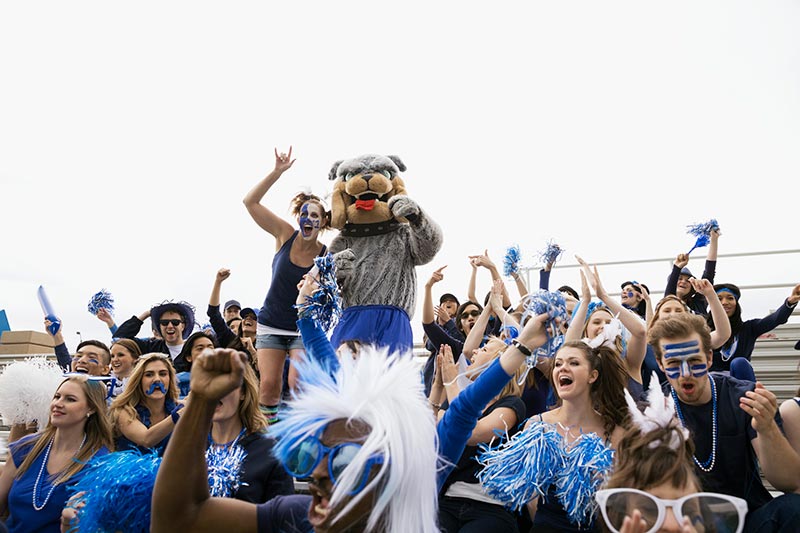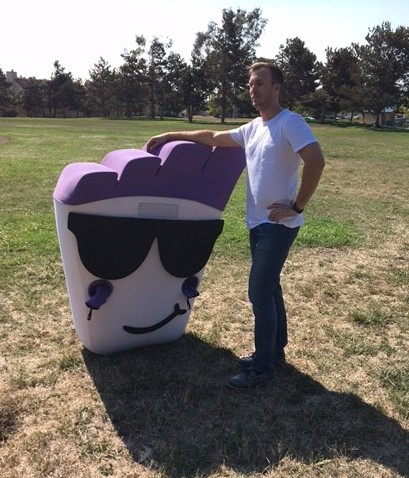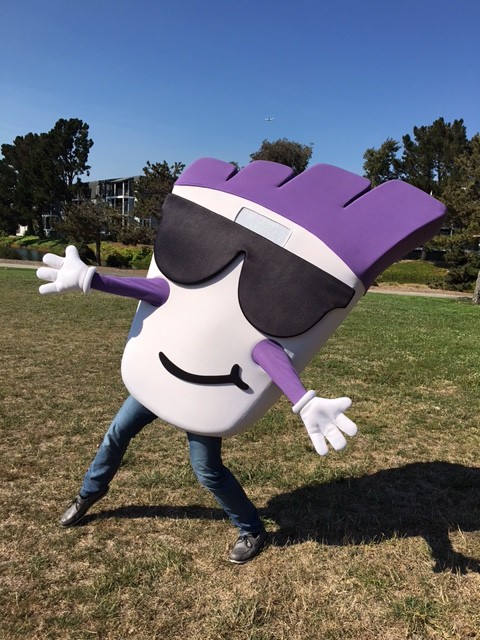
Mascots. You’ve seen them at football games shuffling lifelessly through a crowd, desperately trying to avoid pictures with awestruck children. You’ve seen their uninspiring, lackadaisical dance moves to some of hottest jams. But, for the most part, those are very mediocre mascots.
Being a mascot means more than just sweating in a costume and throwing down slick dance moves. As a mascot, you’re a visible representation of your brand. You have the ability to entertain, inspire, and resonate with your prospects, customers, and fans. Just think about what Flo from Progressive, the GEICO Gecko, Tony the Tiger (They’re Gr-r-reat!), the Kool-Aid Man, and Pillsbury Doughboy represent.
The bottom line is that being a mascot is like being a marketer and vice versa. While not every brand has a mascot nor does every marketer have the chance to be one, the best practices for being a great mascot can be applied to marketing as well. How do I know, you ask? You better sit down for this. What you’re about to hear is top secret: I have proudly represented Marketo as Markie—our mascot (we can call it a hobby)!

After spending time representing Marketo in high-pressure situations, I’ve learned four important lessons that you can apply to your marketing:
1. Prepare Wisely
This is an important first step to being both a mascot and a marketer, but you’d be surprised by how often people forget it. Preparation is not all fun and games when it comes to your dance moves or campaigns. Before attending any event or running any marketing program, there’s a lot of planning that should happen beforehand. Establish your goals, target the right audience, and determine how you’ll track your success.
As a mascot, I’ve learned that it’s important to determine what your role is at the event. What’s the goal for you being there? Who’s the audience—sports enthusiasts or concertgoers? In my case, when I’m the Markie for the day, I need to determine whether I’m there to be awesome Marketo eye-candy, hanging out for photo opps, or whether I’m supposed to bring a more specific entertainment element to the event. That helps determine what I need to do to prepare.
You also need to think through all the technicalities involved. For me, it’s wearing moisture-wicking fabrics, drinking Gatorade (fruit punch is my flavor of choice…yes, it stains), and loading up on candy right before for an energy boost. I’ve also learned that you need to get the costume (and try it on) at least 2-3 hours before the event so you can understand what your limitations are and how that might affect the event you’re at. For example, I’ve learned that it’s impossible to do jumping jacks in the Markie costume and that my vision is obstructed so I can’t see anything by my feet (so I need some clearance and an understanding of the room I’ll be in).
As a marketer, all of these steps are just as important. You have to understand what your goals are so you can determine the strategies and channels you’ll used to accomplish them. If you’re a B2B marketer, should you use broad-based marketing to reach a large number of potential customers or should you use account-based marketing to target specific accounts and the people within them? Should you use digital channels, offline channels, or both? You’ll also need to understand who your target audience is and how they might perceive you so that you can ensure you’re sending relevant, engaging campaigns. Are they new contacts or leads or are they already familiar with your brand? Are you marketing to a consumer audience or other businesses? In terms of the technicalities, what other teams should be involved? Are you coordinating your cross-channel campaigns to deliver a seamless experience?
Bonus Mascot Tip: Practice moving in front of a mirror to see how you look. It’s all about perception and you might need to experiment with different things because the suit is much bigger than you. Plus, then you can practice your sweet moves—The Sprinkler, The Mashed Potato, The Shopping Cart, The Lawnmower, The Running Man, and the ultimate crowd pleaser known as The Cabbage Patch. If you don’t recognize any of these top-notch dance moves, I’m afraid you have some work to do before you can boogie down for your brand.
2. Live and Breathe the Brand
Okay, so let’s say you’ve just been selected for your first gig in your company’s mascot suit. Your initial thought is to tell all of your friends and family about this new development. Facebook will be the first to know, then Twitter, then Instagram, and then Snapchat. Do NOT do this! Becoming a mascot is like becoming a superhero. Revealing your secret identity to the masses could hurt the mascot’s brand identity. You’ll no longer be known as Markie the mascot, but instead Mike in a Markie costume. It might also create a swarm of paparazzi around you and your loved ones. Do you really want to ruin everyone’s trip to the grocery store? Didn’t think so.
So what does this have to do with marketing, aside from mascots being a softer way to sell products? (Markie the Marketo mascot trying to promote Marketo software is better/more fun than Mike trying to promote Marketo software.) As a marketer, you’re representing your brand. Every email, social media post, and display ad that goes out on behalf of your company should represent your brand’s views, not your own. That’s not to say that your knowledge and expertise isn’t valuable, but if your campaigns are coming from your company and not your own social profile or blog, then you should make sure the messaging and values align with your brand’s.
3. Make an Entrance
Do you want everyone in the world to know how awesome your brand is? Of course you do, so make one heck of an entrance. Huge flags, noisemakers, backflips, confetti showers, and white doves fluttering into the air will show everyone at the event that you’ve arrived in style. Stomp on the floor, flail your arms, and come off larger than life.
Everything about you is huge when you’re in a mascot costume: huge head, huge feet, and huge hands, so you need to fill that costume with a huge ego! Typically, mascot costumes can be large and restrictive, so it’s best to double or triple the actions you’d normally take so the crowds can see and feel what you’re saying. Walking can be challenging, so make sure you pick up those feet. A silly wobble, pep in your step, or skip in your walk adds character to your steps, making you more relatable. If you dance, use your entire body. Folks in the back row needs to see those fluid dance moves just as easily as your admirers in the front row.
This is essentially a physical personification of marketing. Your audience is inundated with a tidal wave of messages every single day, whether it’s though social channels, email, digital ads, or television advertisements. By the end of the day, a person can only remember so much. Be different and develop memorable marketing campaigns that cut through all the noise.
In this case, loud distractions might not go over so well with your audience. Instead, work with your team to understand what differentiates your brand and own it. Embody it in your branding, mission statement, content, campaigns, and even your mascot. Markie’s hair is actually the four bars in the Marketo logo that represents elevating company growth and revenue, which has been our core mission from when our company was first founded.
4. Be Respectful
You might not have experienced this yet, but trust me, putting on your company’s mascot suit is an incredible adrenaline rush! You’ll feel more powerful than ever before but with great power comes great responsibility. Treat everyone with respect because your brand depends on it. In a mascot example, this means no picking someone randomly out of the audience for an embarrassing dance montage that they are not into.
Have you ever received an email that you didn’t sign up for? Or felt like a brand didn’t keep their promise to you? Your brand is nothing without a strong foundation for trust. If you have made promises to your buyers, you HAVE to deliver. If you promise them an asset when they fill out a form, deliver it. If you ask for their opt-in for relevant communications, don’t abuse it. Nothing is more off-putting than a brand that follows through sometimes but not always. And this sense of duty shouldn’t stop once your prospects have purchased from you. Customers are your most valuable asset, so treat them with respect and continue to provide value to them!
Not all mascots may be marketers and not all marketers may be mascots, but one thing’s for sure: both are key roles that should embody a brand’s values. Stay true to your brand and everything else will fall in place.
What are some lessons you’ve learned from brand mascots that apply to marketing? Share them in the comments below!

